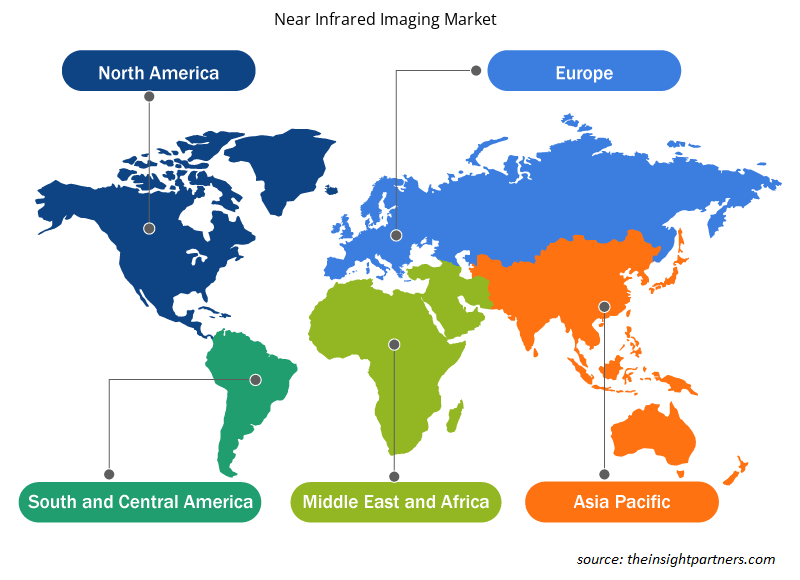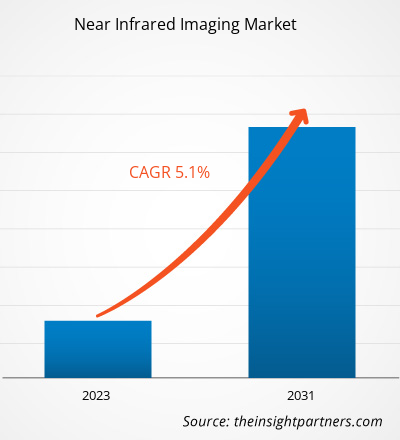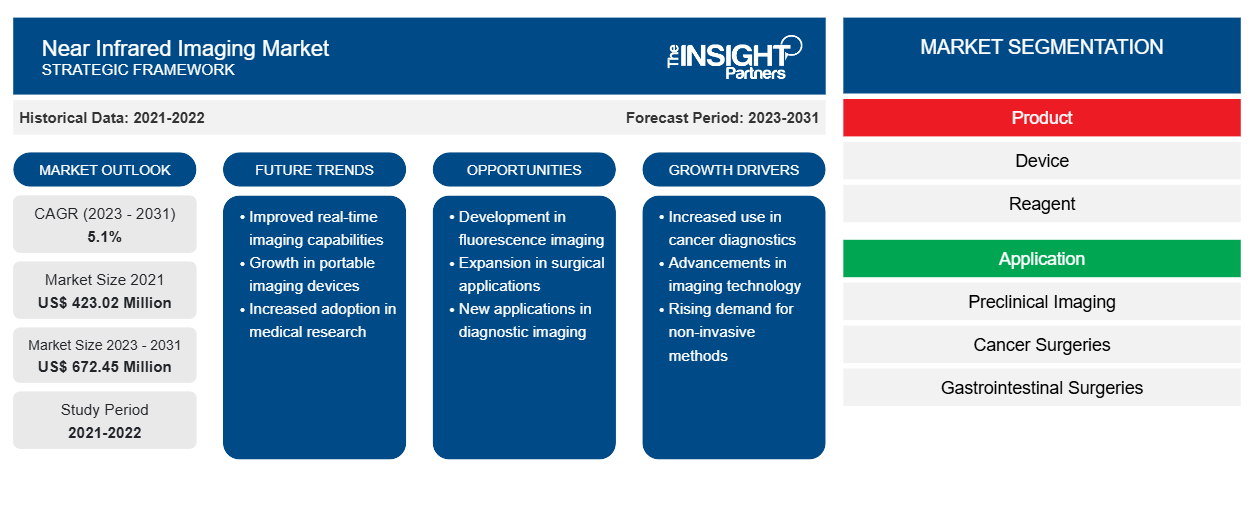Die Größe des Marktes für Nahinfrarot-Bildgebung wurde auf 423,02 Millionen US-Dollar im Jahr 2021 und XX Millionen US-Dollar im Jahr 2023 geschätzt und soll bis 2031 672,45 Millionen US-Dollar erreichen; es wird geschätzt, dass er bis 2031 eine durchschnittliche jährliche Wachstumsrate von 5,1 % verzeichnet. Die Konsolidierung wird voraussichtlich weiterhin ein wichtiger Trend auf dem Markt für Nahinfrarot-Bildgebung bleiben.
Nahinfrarot-Bildgebung Marktanalyse
Die Nachfrage nach Nahinfrarot-Bildgebung (NIR) steigt weltweit, vor allem als Ersatz für Wärmebild- oder Ferninfrarot-Bildgebung (FIR), die für Nachtsicht verwendet wird. Die Nahinfrarot-Bildgebung gilt als leistungsfähiger Ansatz für mehrere landwirtschaftliche Anwendungen. Darüber hinaus ist die Nahinfrarot-Bildgebung gegenüber der Wärmebildgebung vorteilhaft, da die Wärmebildgebung nur dazu beiträgt, Wärme zu absorbieren und keine klaren Bilder erzeugt. Darüber hinaus ist die Nahinfrarot-Fluoreszenz-Krebsbildgebung eine der aufkommenden Techniken für klinische sowie präklinische Anwendungen zur Behandlung von Krebspatienten, da die NIR eine hohe räumliche Auflösung, Echtzeitanzeige, Portabilität und detaillierte molekulare Profilierung mithilfe multiplexierter Fluoreszenzsonden bietet.
Darüber hinaus bietet Licht im nahen Infrarotbereich mit einer Wellenlänge von 650–900 nm gegenüber Licht im sichtbaren Bereich mehrere Vorteile. Dazu gehört die tiefere Gewebedurchdringung aufgrund der geringeren Absorption durch Hämoglobin und Wasser sowie eine geringere Autofluoreszenz des umgebenden Gewebes.
NIR-Fluoreszenzbildgebungsanwendungen sind bei verschiedenen medizinischen Verfahren nützlich, darunter bei der Krebs- und neurologischen Bildgebung. Die NIR-Anwendungen dienen nicht nur als Alternative zu den herkömmlichen Bildgebungsverfahren, sondern kompensieren auch verschiedene Einschränkungen der herkömmlichen Bildgebungstechniken, indem sie einzigartige Funktionen wie NIR-Fluoreszenz einsetzen. Daher wird erwartet, dass die Vorteile der Nahinfrarotbildgebung auch ein wichtiger Faktor sein werden, der das Marktwachstum im Prognosezeitraum vorantreibt.
Marktübersicht für Nahinfrarot-Bildgebung
Das Wachstum des Marktes für Nahinfrarot-Bildgebung dürfte auf Faktoren wie die zunehmende Anzahl chirurgischer Eingriffe und die Vorteile der Nahinfrarot-Bildgebung zurückzuführen sein. Der Mangel an qualifizierten Fachkräften dürfte das Marktwachstum jedoch bis zu einem gewissen Grad behindern. Der globale Markt für Nahinfrarot-Bildgebung ist nach Regionen unterteilt in Nordamerika, Europa, Asien-Pazifik, Naher Osten und Afrika sowie Süd- und Mittelamerika. In Nordamerika halten die USA einen erheblichen Anteil am Markt für Nahinfrarot-Bildgebung. Innovationen bei den NIR-Bildgebungssystemen treiben das Marktwachstum im Land in erster Linie voran. Die Länder in der Region konzentrieren sich auf die Entwicklung fortschrittlicher technologiebasierter Produkte, die zur Verbesserung der Lebensqualität der Patienten beitragen.
Passen Sie diesen Bericht Ihren Anforderungen an
Sie erhalten kostenlos individuelle Anpassungen an jedem Bericht, einschließlich Teilen dieses Berichts oder einer Analyse auf Länderebene, eines Excel-Datenpakets sowie tolle Angebote und Rabatte für Start-ups und Universitäten.
- Holen Sie sich die wichtigsten Markttrends aus diesem Bericht.Dieses KOSTENLOSE Beispiel umfasst eine Datenanalyse von Markttrends bis hin zu Schätzungen und Prognosen.
Markttreiber und Chancen für Nahinfrarot-Bildgebung
Zunehmende Zahl chirurgischer Eingriffe begünstigt den Markt
Der jährliche Bericht „Global Survey on Aesthetic/Cosmetic Procedures“ der International Society of Aesthetic Plastic Surgery (ISAPS) aus dem Jahr 2022 berichtete, dass die Gesamtzahl der von plastischen Chirurgen durchgeführten Eingriffe im Jahr 2022 um 11,2 % gestiegen ist. Der Bericht zeigt auch, dass weltweit mehr als 14,9 Millionen chirurgische Eingriffe durchgeführt wurden. Darüber hinaus weist die Umfrage auf einen stetigen Anstieg der ästhetischen Chirurgie mit einem Anstieg von 41,3 % in den letzten vier Jahren hin. Ein Anstieg der chirurgischen Eingriffe hat den Einsatz von Visualisierungsgeräten zur Durchführung der Operation erhöht. Die Bevölkerung hat sich aufgrund der zunehmenden Zahl chronischer Krankheiten, die durch Arbeitsdruck, Stress, falsche Essgewohnheiten, Vererbung und Kontakt mit Chemikalien verursacht werden, in großem Umfang für die Mikrochirurgie entschieden. Darüber hinaus ist laut der American Society of Plastic Surgeons eine Zunahme der Anzahl verschiedener kosmetischer Operationen zu einem der Hauptfaktoren für das Marktwachstum geworden. Daher wird erwartet, dass die zunehmenden chirurgischen Eingriffe und das steigende Bewusstsein den Markt für Nahinfrarot-Bildgebung in den kommenden Jahren ankurbeln werden.
Schwerpunkt auf Medizintourismus – eine Chance auf dem Markt für Nahinfrarot-Bildgebung
Der Medizintourismus ist einer der Hauptfaktoren, die die Einführung medizinischer Bildgebung, einschließlich NIR, vorantreiben. Der Medizintourismus nimmt in Lateinamerika und im asiatisch-pazifischen Raum zu. Neben diesen Regionen konzentriert sich auch die Region des Nahen Ostens auf den Medizintourismus. Die Länder in diesen Regionen bieten qualitativ hochwertige Dienstleistungen zu niedrigen Preisen an. Angesichts der steigenden Herstellungskosten haben die Hersteller medizinischer Geräte Mühe, ausreichende Einnahmen zu erzielen, um ihre Investoren zufriedenzustellen. Die Schwellenmärkte in den Entwicklungsländern werden voraussichtlich der entscheidende Faktor sein, da sie den wichtigsten Marktteilnehmern bessere und lukrativere Wachstumschancen bieten, um ihr Geschäft und ihre geografische Reichweite zu erweitern.
Die Patienten reisen in andere Länder, um dort eine hochwertige Behandlung mit hochentwickelten und fortschrittlichen Produkten, Geräten und Ausrüstungen der Medizintechnik zu erhalten. Darüber hinaus nimmt auch in den Entwicklungsländern der inländische Medizintourismus zu.
Darüber hinaus konzentrieren sich die Regierungsbehörden im asiatisch-pazifischen Raum auf die Stärkung ihres Medizintourismussektors, um so die Einnahmen zu maximieren. Polen hat sich langsam zum besten Medizintourismusziel Europas entwickelt. So sind beispielsweise die Kosten für medizinische Behandlungen in Polen im Vergleich zu den Kosten in den übrigen EU-Ländern um 60–80 % niedriger. Der Hauptgrund für das Wachstum des Tourismus ist die Anerkennung und Aufnahme Polens in die Europäische Union. Der steigende Medizintourismus in Schwellenländern wie Polen wird den auf dem Markt tätigen Akteuren im Prognosezeitraum voraussichtlich erhebliche Wachstumschancen bieten.
Segmentierungsanalyse des Marktberichts zur Nahinfrarotbildgebung
Wichtige Segmente, die zur Ableitung der Marktanalyse für Nahinfrarot-Bildgebung beigetragen haben, sind Produkt und Endbenutzer.
Basierend auf dem Produkt ist der Markt für Nahinfrarot-Bildgebung in Geräte und Reagenzien unterteilt. Das Gerätesegment hatte 2023 einen größeren Marktanteil. Das Gerätesegment ist weiter unterteilt in Nahinfrarot- Fluoreszenz -Bildgebungssysteme und Nahinfrarot-Fluoreszenz- und Biolumineszenz-Bildgebungssysteme. Das Reagenziensegment ist weiter unterteilt in Indocyaningrün (ICG) und andere Reagenzien.
- Nach Anwendung ist der Markt in präklinische Bildgebung, Krebsoperationen, Magen-Darm-Operationen, Herz-Kreislauf-Operationen, plastische/rekonstruktive Operationen und andere Anwendungen unterteilt. Das Segment Krebsoperationen hatte im Jahr 2023 den größten Marktanteil.
- In Bezug auf den Endverbraucher ist der Markt in Krankenhäuser und Kliniken, Pharma- und Biotechnologieunternehmen sowie Forschungslabore segmentiert. Das Segment Krankenhäuser und Kliniken dominierte den Markt im Jahr 2023.
Nahinfrarot-Bildgebung Marktanteilsanalyse nach Geografie
Der geografische Umfang des Berichts zum Markt für Nahinfrarot-Bildgebung ist hauptsächlich in fünf Regionen unterteilt: Nordamerika, Asien-Pazifik, Europa, Naher Osten und Afrika sowie Südamerika/Süd- und Mittelamerika.
Nordamerika ist der größte Markt für Nahinfrarot-Bildgebung, wobei die USA den größten Marktanteil haben, gefolgt von Kanada. Der US-Markt für Nahinfrarot-Bildgebung dürfte aufgrund des gut etablierten Pharma- und Biotechnologiemarkts wachsen. Das Wachstum ist auch auf die wachsende Forschung und Entwicklung sowie die zunehmende klinische und diagnostische Forschung zurückzuführen. Daher haben die Aktivitäten zur Arzneimittelentwicklung im ganzen Land drastisch zugenommen. Daher wächst im Land die Nachfrage nach Nahinfrarot-Bildgebung.
Darüber hinaus haben einige der führenden Marktteilnehmer ihren Hauptsitz in den USA. Diese Akteure bringen regelmäßig neue und fortschrittliche Produkte auf den Markt. Im Mai 2021 übernahm Teledyne Technologies Incorporated beispielsweise FLIR Systems, Inc. FLIR firmiert unter dem Namen Teledyne FLIR als Teil des Segments Digital Imaging von Teledyne. Der asiatisch-pazifische Raum wird in den kommenden Jahren voraussichtlich die höchste durchschnittliche jährliche Wachstumsrate aufweisen.
Regionale Einblicke in den Markt für Nahinfrarotbildgebung
Die regionalen Trends und Faktoren, die den Markt für Nahinfrarot-Bildgebung im Prognosezeitraum beeinflussen, wurden von den Analysten von Insight Partners ausführlich erläutert. In diesem Abschnitt werden auch die Marktsegmente und die Geografie für Nahinfrarot-Bildgebung in Nordamerika, Europa, im asiatisch-pazifischen Raum, im Nahen Osten und Afrika sowie in Süd- und Mittelamerika erörtert.

- Erhalten Sie regionale Daten zum Nahinfrarot-Bildgebungsmarkt
Umfang des Marktberichts zur Nahinfrarotbildgebung
| Berichtsattribut | Details |
|---|---|
| Marktgröße im Jahr 2021 | 423,02 Millionen US-Dollar |
| Marktgröße bis 2031 | 672,45 Millionen US-Dollar |
| Globale CAGR (2023 - 2031) | 5,1 % |
| Historische Daten | 2021-2022 |
| Prognosezeitraum | 2023–2031 |
| Abgedeckte Segmente | Nach Produkt
|
| Abgedeckte Regionen und Länder | Nordamerika
|
| Marktführer und wichtige Unternehmensprofile |
|
Marktteilnehmerdichte: Der Einfluss auf die Geschäftsdynamik
Der Markt für Nahinfrarot-Bildgebung wächst rasant, angetrieben durch die steigende Nachfrage der Endnutzer aufgrund von Faktoren wie sich entwickelnden Verbraucherpräferenzen, technologischen Fortschritten und einem größeren Bewusstsein für die Vorteile des Produkts. Mit steigender Nachfrage erweitern Unternehmen ihr Angebot, entwickeln Innovationen, um die Bedürfnisse der Verbraucher zu erfüllen, und nutzen neue Trends, was das Marktwachstum weiter ankurbelt.
Die Marktteilnehmerdichte bezieht sich auf die Verteilung der Firmen oder Unternehmen, die in einem bestimmten Markt oder einer bestimmten Branche tätig sind. Sie gibt an, wie viele Wettbewerber (Marktteilnehmer) in einem bestimmten Marktraum im Verhältnis zu seiner Größe oder seinem gesamten Marktwert präsent sind.
Die wichtigsten auf dem Markt für Nahinfrarot-Bildgebung tätigen Unternehmen sind:
- KARL STORZ SE & Co. KG
- Olympus Corporation
- Carl Zeiss Meditec AG
- Leica Microsystem Nussloch GmbH (Danaher)
- Perkin Elmer Inc.
- LI-COR, Inc.
Haftungsausschluss : Die oben aufgeführten Unternehmen sind nicht in einer bestimmten Reihenfolge aufgeführt.

- Überblick über die wichtigsten Akteure auf dem Markt für Nahinfrarot-Bildgebung
Nachrichten und aktuelle Entwicklungen zum Nahinfrarot-Bildgebungsmarkt
Der Markt für Nahinfrarot-Bildgebung wird durch die Erfassung qualitativer und quantitativer Daten nach Primär- und Sekundärforschung bewertet, die wichtige Unternehmensveröffentlichungen, Verbandsdaten und Datenbanken umfasst. Im Folgenden finden Sie eine Liste der Entwicklungen auf dem Markt für Nahinfrarot-Bildgebung und Strategien:
- Im März 2024 hat Artience Co., Ltd. die Sciforiem FI-Serie auf den Markt gebracht, eine hochempfindliche Nahinfrarot-Fluoreszenzsonde, die von TOYOCOLOR CO., LTD. hergestellt und verkauft wird. (Quelle: Artience Co., Ltd., Pressemitteilung, 2024)
- Im Juli 2023 brachte Nikon Corporation den AX R MP mit NSPARC-Superauflösungs-Multiphotonen-Konfokalmikroskop auf den Markt, das eine extrem empfindliche Array-Erkennung und Superauflösung in tiefen Bereichen innerhalb großer lebender Organismusproben ermöglicht. (Quelle: Nikon Corporation, 2023) [AT9]
- Im August 2022 stellte das in Japan ansässige Unternehmen Shimadzu das Nahinfrarot-Bildgebungssystem LuminousQuester NI vor. Dieses System besteht aus einer Kamera, die Nahinfrarotlicht und sichtbares Licht gleichzeitig abbilden kann, sowie einer speziellen Software. Es ist für nicht-klinische Forschungsanwendungen konzipiert und unterstützt die Arzneimittelforschung, indem es eine hochflexible Kamera, die in einer Vielzahl von Umgebungen eingesetzt werden kann, mit einer Software kombiniert, die ein hohes Maß an Benutzerfreundlichkeit aufweist. (Quelle: Shimadzu, Pressemitteilung, 2022)
- Im Juni 2022 startete die Stryker Endoscopy Latam Franchise die +FOCO-Kampagne. Die +FOCO-Kampagne lieferte mehr Wissen und Informationen über INDOCIANINE GREEN FLUORESCENCE (ICG)*, eine Methode zur Visualisierung des Blutflusses und der Gewebedurchblutung mithilfe eines grünen Pigments, das durch Nahinfrarotlicht aktiviert wird und bei Verwendung fortschrittlicher Bildgebungsmodule wie STRYKER AIM-Kameras fluoreszierend (grün) wird. (Quelle: Stryker, Pressemitteilung, 2022)
Marktbericht zur Nahinfrarot-Bildgebung – Abdeckung und Ergebnisse
Der Bericht „Marktgröße und Prognose für Nahinfrarot-Bildgebung (2021–2031)“ bietet eine detaillierte Analyse des Marktes, die die folgenden Bereiche abdeckt:
- Marktgröße und Prognose auf globaler, regionaler und Länderebene für alle wichtigen Marktsegmente, die im Rahmen des Projekts abgedeckt sind
- Marktdynamik wie Treiber, Beschränkungen und wichtige Chancen
- Wichtige Zukunftstrends
- Detaillierte PEST/Porters Five Forces- und SWOT-Analyse
- Globale und regionale Marktanalyse mit wichtigen Markttrends, wichtigen Akteuren, Vorschriften und aktuellen Marktentwicklungen
- Branchenlandschaft und Wettbewerbsanalyse, einschließlich Marktkonzentration, Heatmap-Analyse, prominenten Akteuren und aktuellen Entwicklungen
- Detaillierte Firmenprofile
- Historische Analyse (2 Jahre), Basisjahr, Prognose (7 Jahre) mit CAGR
- PEST- und SWOT-Analyse
- Marktgröße Wert/Volumen – Global, Regional, Land
- Branchen- und Wettbewerbslandschaft
- Excel-Datensatz
Aktuelle Berichte
Erfahrungsberichte
Grund zum Kauf
- Fundierte Entscheidungsfindung
- Marktdynamik verstehen
- Wettbewerbsanalyse
- Kundeneinblicke
- Marktprognosen
- Risikominimierung
- Strategische Planung
- Investitionsbegründung
- Identifizierung neuer Märkte
- Verbesserung von Marketingstrategien
- Steigerung der Betriebseffizienz
- Anpassung an regulatorische Trends





















 Kostenlose Probe anfordern für - Markt für Nahinfrarot-Bildgebung
Kostenlose Probe anfordern für - Markt für Nahinfrarot-Bildgebung